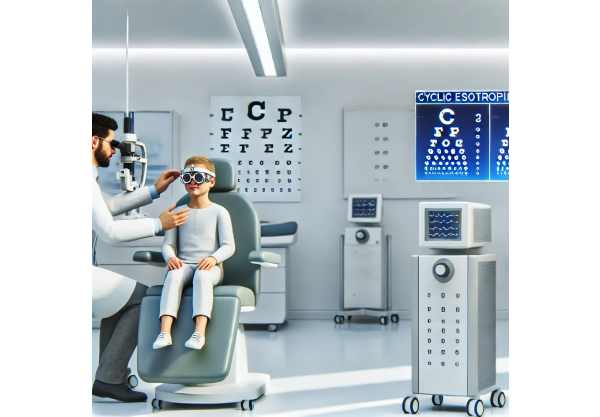
Cyclic esotropia is a rare but intriguing form of strabismus (eye misalignment) where the eyes alternate between periods of normal alignment and distinct inward turning, often following a precise and predictable cycle. While most commonly seen in children, this condition poses unique diagnostic and management challenges for all ages. In this comprehensive, SEO-optimized guide, we will unravel the mysteries of cyclic esotropia, review proven medical and surgical solutions, and highlight cutting-edge advances that are shaping the future of strabismus care.
Table of Contents
- Understanding Cyclic Esotropia: Patterns and Population Trends
- Conservative Therapies and Non-Invasive Management
- Surgical Corrections and Modern Strabismus Techniques
- Advances in Treatment and Emerging Technologies
- Current Clinical Studies and the Road Ahead
- Frequently Asked Questions
Understanding Cyclic Esotropia: Patterns and Population Trends
Cyclic esotropia is a unique strabismic disorder where periods of esotropia (inward turning of one or both eyes) alternate with periods of normal, aligned eyes—often following a regular 24- to 48-hour rhythm. Typically, the condition appears in children, though adults can also be affected. Unlike constant or intermittent esotropia, the predictability and strict periodicity set cyclic esotropia apart.
Pathophysiology and Presentation
- The exact cause is unknown but likely involves disruption in the brain’s ocular alignment control centers or a malfunction in circadian neurological regulation.
- Affected individuals exhibit a “cycle”—for example, one day of crossed eyes followed by one day of straight eyes, repeating regularly.
- Symptoms include double vision, eye strain, headaches, and sometimes diminished depth perception during esotropic phases.
Epidemiology and Risk Factors
- Cyclic esotropia is rare, accounting for less than 1% of all strabismus cases.
- Most often diagnosed in early childhood (ages 2–7), but there are reports in teens and adults.
- No strong genetic predisposition, though family history of strabismus may increase risk.
- Occasionally triggered by prior eye surgery, trauma, or neurological events.
Typical Features
- Cyclic, predictable switching between orthotropia (normal alignment) and esotropia.
- Associated symptoms vary in intensity depending on the phase.
- Amblyopia (“lazy eye”) may develop in young children if the esotropia is untreated.
Practical Advice:
If your child has days of “straight eyes” and others with crossing, keep a calendar or photo log of symptoms. Bring this to your pediatric ophthalmologist—pattern recognition is key to diagnosis.
Conservative Therapies and Non-Invasive Management
Many cases of cyclic esotropia initially receive non-surgical interventions—especially when the misalignment is mild or the child is young. While these approaches rarely offer a permanent cure, they can alleviate symptoms and support healthy visual development.
Non-Surgical Approaches
- Refractive Correction
- Full prescription of glasses is essential, particularly if there is hyperopia (farsightedness).
- Correcting refractive error can reduce eye strain and minimize the deviation during the esotropic phase.
- Patching Therapy
- Temporary patching of the stronger eye may prevent amblyopia in children with poor vision in one eye.
- Typically prescribed for several hours a day during esotropic phases.
- Prism Lenses
- Specialized lenses that redirect light can reduce double vision during esotropic episodes.
- Most effective for older children or adults who experience persistent diplopia.
- Vision Therapy and Eye Exercises
- In select cases, exercises to enhance binocular vision and fusion may help, though results are variable.
- Observation
- Close monitoring may be advised if the condition is very mild, improving, or if surgical timing is being optimized.
Medical Management
- Rarely, medications such as botulinum toxin injections are used as a temporary measure in select patients—mainly when surgery must be postponed or for diagnostic purposes.
Limitations
- Conservative therapies do not cure the cyclic pattern but can delay progression, preserve function, and prepare for surgery.
- Most children eventually require surgical intervention for long-term alignment.
Long-Tail Keywords Used Here:
- non-surgical treatment for cyclic esotropia
- prism glasses for eye turning
- patching therapy for strabismus
Practical Advice:
If your child’s glasses prescription is updated, encourage full-time wear and monitor for improvement in symptoms before considering further steps.
Surgical Corrections and Modern Strabismus Techniques
For most patients with cyclic esotropia, surgery remains the definitive treatment—effectively breaking the abnormal cycle and restoring stable alignment.
Key Surgical Approaches
- Bilateral Medial Rectus Recession
- The most common procedure: both medial rectus muscles (responsible for pulling the eyes inward) are repositioned farther back on the eyeball, weakening their action and aligning the eyes.
- This approach has proven highly effective for cyclic esotropia.
- Unilateral Surgery
- Sometimes only one eye is operated on, especially if one eye is more affected.
- Adjustable Suture Techniques
- Surgeons may use adjustable sutures to fine-tune alignment in the days following surgery, increasing precision and reducing the risk of over- or under-correction.
- Botulinum Toxin Injection
- Occasionally, Botox is injected into the medial rectus muscle(s) as a temporary alternative or in preparation for more permanent surgery.
- Innovative Approaches
- New minimally invasive methods and novel suture placements are under research to further refine outcomes and minimize recurrence.
Postoperative Care and Recovery
- Children typically recover rapidly, with return to normal activities within days.
- Temporary redness or swelling is expected but usually mild.
- Most patients achieve lasting, stable alignment and resolution of the cyclic pattern.
Risks and Considerations
- Under- or overcorrection, need for repeat surgery, or very rare complications (such as infection or scarring).
- Follow-up visits are crucial to ensure optimal results and monitor for late recurrence.
Long-Tail Keywords Used Here:
- strabismus surgery for cyclic esotropia
- recovery after eye muscle surgery
- adjustable suture technique for eye alignment
Practical Advice:
Arrange for post-surgical follow-ups and ask your surgeon about warning signs (such as persistent redness or double vision) that may require prompt attention.
Advances in Treatment and Emerging Technologies
Recent years have seen an explosion of innovation in strabismus care—especially for complex or unusual cases like cyclic esotropia.
Breakthroughs in Diagnosis and Management
- Digital Eye Tracking
- High-precision eye tracking technology helps document the periodicity and severity of cyclic esotropia for both diagnosis and surgical planning.
- Telemedicine and Remote Monitoring
- Parents can use smartphone apps to document and securely share video or photo evidence of cycles, enhancing diagnosis and post-surgical follow-up.
- AI and Automated Analysis
- Artificial intelligence is now being developed to analyze home videos, identify cycles, and help predict optimal intervention timing.
- 3D Imaging and Surgical Planning
- Advanced imaging supports customized surgical mapping for safer, more predictable outcomes.
Emerging Surgical and Medical Innovations
- Minimally Invasive Eye Muscle Surgery
- Smaller incisions, reduced tissue disruption, and faster recovery are key goals.
- Robotic-assisted techniques are in early stages of development.
- Personalized Surgery Based on Genetic Markers
- Research is underway to identify genetic factors influencing cyclic esotropia, potentially enabling tailored interventions.
- Gene Therapy and Neuroregulation
- Early trials are exploring gene-based and neuroregulatory interventions to restore normal eye alignment without invasive surgery.
Long-Tail Keywords Used Here:
- new technology for strabismus surgery
- AI in cyclic esotropia diagnosis
- digital eye tracking for eye misalignment
Practical Advice:
If you’re considering surgery, ask your ophthalmologist about advanced imaging or technology-enhanced approaches available at their center.
Current Clinical Studies and the Road Ahead
The future of cyclic esotropia management looks increasingly precise, personalized, and non-invasive.
Active and Emerging Research
- Long-Term Outcomes of Adjustable Suture Surgery
- Studies are underway to optimize adjustable techniques and minimize recurrence or late complications.
- Genetic and Biomarker Research
- New projects are mapping the genetic basis of cyclic esotropia, aiming for targeted therapies.
- Smartphone-Based Home Monitoring
- Trials are assessing the accuracy and utility of mobile devices for home-based monitoring and remote consultation.
- Telehealth and Global Access
- Expanding telemedicine is increasing access to pediatric ophthalmology expertise, especially in underserved areas.
- Neuroplasticity and Non-Surgical Approaches
- Research is investigating the potential for non-surgical “resetting” of neural pathways using brain stimulation, pharmacology, or digital therapy.
The Next Decade
- Earlier and more accurate diagnosis—especially with AI and digital tracking
- Safer, more effective, and less invasive surgeries
- Individualized risk prediction and long-term management plans
- Widespread access to expert care, no matter where you live
Long-Tail Keywords Used Here:
- clinical trials for cyclic esotropia
- future of strabismus treatment
- non-surgical therapy for eye misalignment
Practical Advice:
Participate in registries or studies if you’re eligible—they often provide access to advanced care while contributing to better understanding and outcomes for all.
Frequently Asked Questions
What is cyclic esotropia and how is it different from other types?
Cyclic esotropia is a rare form of strabismus where inward eye turning occurs on a regular, predictable schedule—typically every other day—unlike constant or intermittent types.
What causes cyclic esotropia?
The exact cause is unclear, but it likely involves neurological regulation errors in the brain’s control of eye alignment. Genetics, surgery, or trauma may play a role.
How is cyclic esotropia diagnosed?
Diagnosis is based on observing a predictable cycle of eye turning and normal alignment. Keeping a symptom diary and video/photo records can be very helpful for your doctor.
What are the treatment options for cyclic esotropia?
Initial management may include glasses, prism lenses, or patching. Most patients eventually benefit from surgery to correct eye muscle alignment and stop the cycles.
Is surgery for cyclic esotropia effective?
Yes, most children and adults achieve permanent resolution of the cyclic pattern and improved alignment with surgery, especially with modern techniques like adjustable sutures.
Can cyclic esotropia recur after treatment?
Recurrence is rare with proper surgical technique but can happen. Regular follow-up ensures early detection and prompt management if needed.
Are there any new advances in treating cyclic esotropia?
Recent advances include AI-powered diagnosis, digital eye tracking, minimally invasive surgery, and ongoing research into genetic and neuroregulatory therapies.
Disclaimer:
This article is for educational purposes only and should not be considered a substitute for medical advice. If you or your child are experiencing symptoms of cyclic esotropia or any eye misalignment, consult a qualified eye specialist as soon as possible.
If you found this article helpful, please share it on Facebook, X (formerly Twitter), or any social network you prefer. Your support helps us bring high-quality, evidence-based eye health resources to more families. Stay connected and follow us for more updates—thank you!










